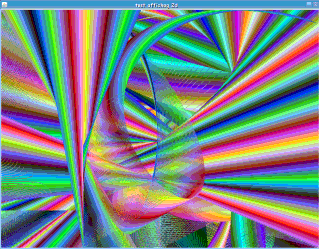
Java: playing with Java 2D

There’s sometime ago I wanted to see how java 2D was working.
I came from Amiga computers, where doing double buffering was part of your job in C.
But using accellerated 2D java engine seems a lot simpler as it do the job for you 😉
Below is a little java class I coded to experiment java 2D with double buffering.
It may be wrong now since this code is quite old and its also a lot slower than the same
code on an Amiga 4000 using C language.
|
1 2 3 4 5 6 7 8 9 10 11 12 13 14 15 16 17 18 19 20 21 22 23 24 25 26 27 28 29 30 31 32 33 34 35 36 37 38 39 40 41 42 43 44 45 46 47 48 49 50 51 52 53 54 55 56 57 58 59 60 61 62 63 64 65 66 67 68 69 70 71 72 73 74 75 76 77 78 79 80 81 82 83 84 85 86 87 88 89 90 91 92 93 94 95 96 97 98 99 100 101 102 103 104 105 106 107 108 109 110 111 112 113 114 115 116 117 118 119 120 121 122 123 124 125 126 127 128 129 130 131 132 133 134 135 136 137 138 139 140 141 142 143 144 145 146 147 148 149 150 151 152 153 154 155 156 157 158 159 160 161 162 163 164 165 166 167 168 169 170 171 172 173 174 175 176 177 178 179 180 181 182 183 184 185 186 187 188 189 190 191 192 193 194 195 196 197 198 199 200 201 202 203 204 205 206 207 208 209 210 211 |
import javax.swing.*; import java.awt.*; import java.awt.image.*; import java.awt.event.*; // main window public class MainWindow extends Canvas { /* The stragey that allows us to use accelerate page flipping */ private BufferStrategy strategy; // constructor public MainWindow() { // create window JFrame container = new JFrame("Java 2d test"); // get hold the content of the frame and set up the resolution of the game JPanel panel = (JPanel) container.getContentPane(); panel.setPreferredSize(new Dimension(800,600)); panel.setLayout(null); // setup our canvas size and put it into the content of the frame setBounds(0,0,800,600); panel.add(this); // Tell AWT not to bother repainting our canvas since we're // going to do that our self in accelerated mode setIgnoreRepaint(true); // finally make the window visible container.pack(); container.setResizable(false); container.setVisible(true); // add a listener to respond to the user closing the window. If they // do we'd like to exit the game container.addWindowListener(new WindowAdapter() { public void windowClosing(WindowEvent e) { System.exit(0); } }); addKeyListener(new keyhandler()); // get focus to receive key events requestFocus(); // create the buffering strategy which will allow AWT // to manage our accelerated graphics createBufferStrategy(2); strategy = getBufferStrategy(); // start Draw(); } public void Draw() { int j = 0 , i = 0, r = 255,g = 255, b=255, mr = -1,mg = -1,mb = -1; int endw = 800, endh = 600, mw=1, mh = -1; // Get hold of a graphics context for the accelerated // surface and blank it out Graphics2D gfx = (Graphics2D) strategy.getDrawGraphics(); gfx.setColor(Color.black); gfx.fillRect(0,0,endw,endh); gfx.setColor(Color.white); while(true) { gfx.setColor(new Color(r,g,b)); gfx.drawLine(i,j,endw-i,endh-j); //gfx.draw3DRect(i,endh,i,endw,false); gfx.drawArc(i, j, endw, endh, 45-i, 90+j); // finally, we've completed drawing so clear up the graphics // and flip the buffer over //g.dispose(); strategy.show(); if(i < 800) i++; else { j++; if(j > 600) { j = 0; i = 0; } } r = r + (2*mr); g = g + (5*mg); b = b + (10*mb); if(r <= 5) mr = 1; else if(r >= 250) mr = -1; if(g <= 5) mg = 1; else if(g >= 250) mg = -1; if(b <= 5) mb = 1; else if(b >= 250) mb = -1; endw+=mw; endh+=mh; if(endw >= 1200) mw = -1; else if(endw <= 300) mw = 1; if(endh >= 900) mh = -1; else if(endh <= 50) mh = 1; try { Thread.sleep(1); } catch (Exception e) {} } } private class keyhandler extends KeyAdapter { public void keyTyped(KeyEvent e) { System.exit(0); } } // main function public static void main(String[] args) { new MainWindow(); } } |
Link to this post!